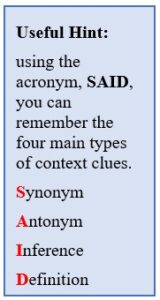
There are five (5) different types of context clues.
- Synonym Clues/Restatement – Similar-sounding words are used within the same sentence or around the unfamiliar word.
For example, Buddy the dog was so large that his doctor declared him overweight.
2. Antonym Clues/Contrast – The new/unfamiliar word is defined by using the word’s opposite or contrasting meaning. Context clues of this type typically include the words: unlike, whereas, in contrast to, on the other hand and but.
For example, Freddy had an effervescent personality while Joey was always quite sour.
3. Inference/General Context Clues – Although word meanings are not clearly stated in the text, definitions of unfamiliar words can be assumed based on prior knowledge and the context in which the word appears.
For example, the girl looked so maga that her new family immediately sent her to the kitchen for a meal.
4. Definition of explanation clues – These are unfamiliar words which are explained directly after use.
For example, the curator, the person who looks after the artifacts at a museum, works very hard.
5. Punctuation– The clues in this type of context clue are hidden in capitalization, italicization, quotation marks, and even parentheses. With these, you can see how the clues inform the reader that the word could be a name, a book title, or even that the word is being defined for us.
For example, the examples the student gave were pertinent; they were directly related to the topic.
